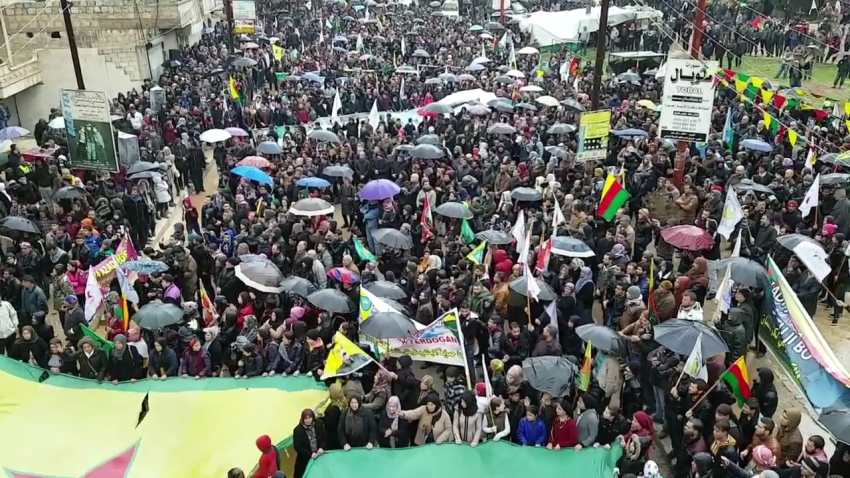
The Turkish army and its local Free Syrian Army (FSA) allies reportedly entered the city of Afrin in the early hours of March 18.
At first sight, this might seem an important victory for Turkey and its modern caliph Recep Tayyip Erdogan. But at closer inspection, and from a broader perspective, it can be seen as a victory for the Kurdish-led project of democratic confederalism in Syria.
Firstly, in pure military terms, any assessment of the battle of Afrin ought to take into account the sheer inequality between the Turkish invading army and the much smaller force of multi-ethnic Syrian Democratic forces (SDF) that resisted it.
A few thousand SDF fighters, armed with light and outdated weapons, displayed legendary courage and determination to confront NATO’s second largest army, which acted in utter disregard for international humanitarian law.
Given this blatant imbalance of forces, what is surprising is that SDF was able to resist for nearly two months while effectively lacking secure and stable supply lines.
Although much of Afrin is now under Turkish occupation, there are pockets of territory controlled by SDF in the hillier parts of the region. The significance of this will be clearer in light of SDF’s announcement it will wage a guerrilla war against the occupying Turkish army and the FSA in the region.
The manner of SDF withdrawal from Afrin city and its agility as a disciplined military force is also noteworthy. The SDF proved it could rapidly adjust to different battlefield circumstances in a small territory more or less entirely encircled by hostile or unfriendly forces.
Secondly, in strategic terms, Afrin was always Rojava’s soft underbelly, vulnerable to Turkish invasion. Those commentators who often speak of Afrin’s importance in terms of it being the territorial link between Rojava’s heartland, which lies to the East of Euphrates, and the Mediterranean Sea fail to appreciate that democratic confederalism is not a nation-state formation project requiring a contiguous territory with a Kurdish majority. Any part of Syria with whatever ethno-linguistic makeup can be part of that project.
The experience of Arab majority regions in Raqqa, Deir al-Zour and Manbij joining the Democratic Federation of Northern Syria (DFNS) demonstrates this.
Moreover, by more or less eliminating the Russian variable from the SDF’s military calculations with regards to the Western Euphrates, the battle of Afrin is likely to bring clarity to the strategic thinking of the DFNS.
Thirdly, in political terms, the battle of Afrin clearly demonstrated, and is likely to reinforce, the political autonomy of the SDF and DFNS.
Russia, in coordination with Iran and the Bashar al-Assad regime, had offered to avert the Turkish invasion if SDF surrendered Afrin to the Syrian regime. The SDF’s refusal to accept this deal clearly refutes the allegation often made by the revolution’s critics that the SDF and DFNS are the Assad regime’s political allies.
The decision is therefore bound to strengthen the prestige and credibility of SDF/DFNS among the secular elements of the Syrian opposition unconnected to Turkey. It will also do so with many ordinary Syrians who see the failure of the Assad regime to defend Syrian lands against an invading army.
And finally, and perhaps most importantly, there is a historical dimension to any battle or war whose long-term significance often overweighs its military, strategic or political effects.
Historically speaking, military defeats following valiant defence have provided as much symbolic material for forging collective identities and generating popular political energy as great victories.
Indeed, the Kurdish freedom movement’s historical sinew is animated by the symbolic legacy of such defeats. The fall of the “Castle of DimDim” to Iran’s Safavid forces following a prolonged siege (1609), the destruction of the Ararat Republic by the newly-born Turkish Republic (1930), and the chemical attack on Halabja by the Iraqi Ba’ath regime (1988) are only few notable cases in point.
The effects of this historical and symbolic dimension of the battle of Afrin are strengthened by the actions of the invading Turkish army itself. After weeks of indiscriminate bombing and shelling of Afrin and upon entering Afrin city, Turkish forces and their allies immediately destroyed the statue of Kawa, the mythological Kurdish hero, in the central square of the city.
Kawa’s overthrow of the monstrous king Zuhak is central to Kurds’ collective identity and political self-consciousness. The fact that the Turkish army inaugurated its occupation of Afrin with the destruction of Kawa’s statue is bound to demonstrate to all fair observers the fundamental and racialised hostility of the Turkish state to the Kurdish existence.
The battle of Afrin has in fact already become a modern legend and is bound to further inspire and animate Kurdish struggle for cultural and political freedom and recognition. And this is a victory.
[Abridged from The Region.]
Like the article? Subscribe to Green Left now! You can also like us on Facebook and follow us on Twitter.